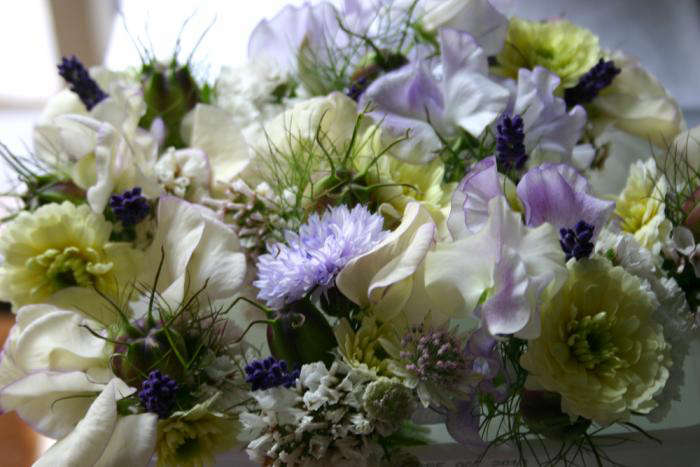Georgie Newbery is known as The Flower Farmer, and she keeps the same ungodly hours as a regular farmer.
Up with the lark and to bed when most of us are wondering what to have for dinner, she is totally focused on the next order for her cut flowers: conceived, grown, cut, and dispatched from Common Farm Flowers, her smallholding in Somerset.
Georgie and husband Fabrizio are the cut-flower equivalent of Doris Day and David Niven in Please Don’t Eat the Daisies. They may not have a friendly American housekeeper, but they do live with children, a dog, the occasional pig, and 100,000 bees. Fabrizio is an artist. Amid all this, Georgie produces bouquets to be sent all over England, while supplying big parties and small country weddings. She also runs courses from her farmhouse kitchen. She is very charming and has a lot of fans. The best thing about Common Farm Flowers, though, is the flowers: they are unsprayed, British, and a little bit wild.
Photographs by Georgie Newbery.

Above: After making a list of flowers for a big occasion, Georgie starts by scrubbing all of her flower buckets, filling them with water, and setting them out, ready. “We don’t use silver-nitrate in the water as a preservative,” says Georgie. “In hot weather–what’s that?–we add a drop of white vinegar to the flower water.” This prevents a build-up of bacteria, which could drastically shorten the shelf life of the flowers.
Georgie cuts flowers according to the list she makes after conferring with a client. “I have to be careful because all the while we are sending out bouquets by post, so for the week before an event I keep the flowers back which the client has asked for, and send different kinds of bouquets out. At times this is a bit of a juggle.” Cutting the flowers for a big “do” can take the best part of a day. “If the weather’s hot, I cut very early in the morning and after the sun’s gone in the evening,” continues the tireless Georgie. “It takes a total of about five hours to cut a big party. And then it takes another six or seven to do the arranging.”

Above: “When all the buckets are full–usually the Thursday night before a weekend party–I can start making the flower arrangements,” says Georgie. A party might include 30 table decorations; added to that, several larger arrangements to be placed in front of fireplaces in the great hall of a Tudor manor house for instance, and in a few mullioned window embrasures…

Above: Sweet peas, love-in-a-mist, lavender, chrysanthemum, cornflower, and astrantia. “Right at the last minute I make up the bride’s bouquet and the buttonholes. And then the whole is delivered to the venue with a few buckets of spares in case,” says Georgie.

Above: “It’s hard work but very satisfying when I get thrilled responses from a client,” says Georgie. “We are the only company in England (as far as I know) who grow wild flowers especially to use in our arrangements. We don’t use chemical pesticides. We garden always with the wildlife in our seven-acre plot in mind.”

Above: The shed that overlooks the dahlia and rose beds at Common Farm Flowers.

Above: Lathyrus Charlie’s Angel. “We grow a great variety of perennials, shrubs and annuals here at Common Farm Flowers,” says Georgie. “This is how we manage to keep cutting even through the most miserable summer ever. If we’d put all our eggs in one basket–made of sweet peas–we’d be in serious trouble by now. Fortunately we do have some sweet peas in the polytunnel and these we are still cutting, though we cut our first from them in May.”

Above: Rose Shropshire Lad growing against a hawthorn hedge. The same variety of rose can flower at different stages depending on its location; useful for staggering the blooms.

Above: The gardens at Common Farm are divided into different cutting areas, surrounded by native hedges and individually rabbit-proofed. “This one is called The Piggery because our first two pigs cleared and manured the land for our first raised beds,” says Georgie.

Above: Georgie’s kitchen. “Our floristry is ruthlessly unorthodox in that I believe in bringing the garden into the house with every design I make.” (N.B.: Looking for more farmhouse inspiration? See 51 images of Farmhouses in our Gallery of rooms and spaces.)












Have a Question or Comment About This Post?
Join the conversation (0)